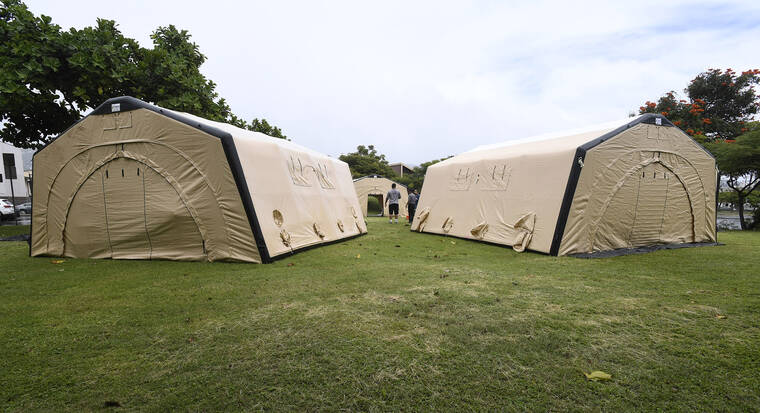Three new Hawaii laws were enacted Friday to expand housing assistance and production serving the homeless as well as sheltered households earning up to the median income.
Gov. David Ige on Friday signed the three bills, which became law immediately, including one that will prevent a previously scheduled June 30, 2023, end to the state’s 4-year-old “ohana zones” pilot program.
The other two measures provide $300 million to help finance development of housing for low- and moderate-income households and boost rental assistance payments for needy parents with minor children.
Ige first signed House Bill 2512, which extends by three years the ohana zones program providing shelter and services to homeless people on state or county property.
The bill, now Act 235, also appropriates $15 million to expand and continue running the program, which has helped 5,510 homeless people statewide, including 1,368 who received permanent housing as of late 2021.
“The ohana zones pilot program proved to be very, very successful,” Ige said during a bill-signing ceremony in his office at the state Capitol.
Under the program, the state and counties have worked together to support 20 homeless shelter projects. Examples include the mobile tent-based Homeless Outreach and Navigation for Unsheltered (HONU) program, which included 80 beds on Oahu in 2021, and a 12-unit project called Huliau on Maui created by reusing student housing on the University of Hawaii Maui College campus in Kahului.
The bill to extend and expand the program was introduced by 46 members of the House of Representatives and drew supportive testimony at the Legislature from the counties, nonprofit homeless service providers, housing advocates and others.
The second law enacted Friday with Ige’s signing of SB 3048 provides record funding for a state program that helps private developers build primarily low- income housing.
Under the measure, the Hawaii Housing Finance and Development Corp. will receive $300 million for a rental housing revolving fund to make low-interest loans or grants to developers as partial financing for rental housing construction.
HHFDC in recent years received $25 million-to- $50 million appropriations from the Legislature for the fund after a record $200 million in 2018. The new $300 million contribution is expected to be enough to help finance construction of 1,938 rental units and rehabilitation of 800 more.
The bill signed into law also allows HHFDC to dedicate up to half of the $300 million to projects that serve more moderate-income households as opposed to low-income projects, which typically receive rental housing fund awards.
Denise Iseri-Matsubara, the agency’s director, said during the ceremony that the new law presents an exciting opportunity to produce rental housing for households earning between 60% and 100% of the median income — what she called the “missing middle” for which HHFDC typically doesn’t help finance housing development.
“We’re talking about households earning between $78,000 to $130,000 a year for a family of four on Oahu as an example,” she said. “This group typically makes too much to qualify for a low-income rental but not enough to sustain a mortgage.”
Iseri-Matsubara thanked lawmakers and the governor for making affordable- housing development a priority.
“This is certainly a banner year for affordable housing and for HHFDC,” she said.
State Sen. Stanley Chang and state Rep. Nadine Nakamura, who respectively chair the Senate and House committees on housing, both used the word “historic” to describe the pieces of legislation Ige signed Friday.
The last bill signed was HB 2233, which allows the state Department of Human Services to provide rent subsidies up to $500 per month for needy parents with minor children in the federally funded Temporary Assistance for Needy Families program and a state version for non-U.S. citizens.
These programs — which require participation in another program called First- to-Work, which helps the parents gain employment — provide cash benefits for food, clothing, housing and other essential needs. Most of the benefits are available for up to five years, though the housing benefit was limited to only two months of rent.
“This is clearly a population in need, and the $500 subsidy can make a huge difference in ensuring that they can get access to housing as well,” Ige said.

